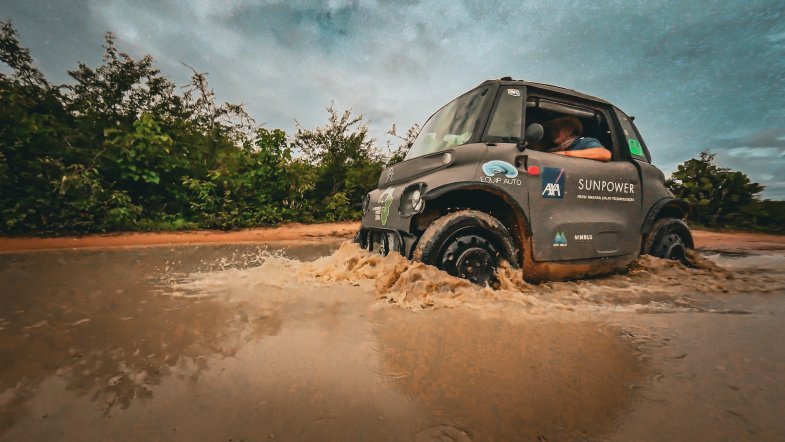27/10/2025
La Croisière Verte 2024: in the footsteps of André Citroën, the adventure goes electric with the Ami
By Oscar Litt
Journaliste

A century after the Croisière Noire, a journey across Africa in an electric Citroën Ami pays tribute to the brand's pioneering spirit, while paving the way for sustainable mobility on the African continent.
It's an idea in line with Citroën's history: a hundred years after the legendary Croisière Noire, the Croisière Verte is repeating the adventure by connecting Europe to Africa aboard small electric Citroën Amis recharged with solar energy in a four cars’ convoy. The initiative led by rally-raid enthusiast Eric Vigouroux is a direct tribute to the vision of André Citroën who saw the automobile as a means of exploring the world and bringing people together.
“Our ambition was to reproduce what André Citroën achieved a hundred years ago, but with today's technology,” explains Eric Vigouroux. “We wanted to show that you don't need big cars to accomplish great things.”
During the past decades, the European automotive industry has been engaging with institutions to reform regulations to promote more fuel-efficient electric cars. Thus, this expedition is highly symbolic of a new era in the industry. As in 1924, it symbolizes a meeting between technological innovation and the spirit of adventure. This time, the feat consists of traveling 17,300 km in four months in 100% low-voltage (48-volt) electric cars, recharged using solar panels installed in the cars in place of the passenger seat. These panels, which take about an hour to install, allowed the batteries to be fully charged in five hours.
To minimize energy consumption, the four drivers adopted a radically economical driving style, driving “by kWh” with a target of 2 kWh. As a result, their speed fluctuated between 10 km/h on uphill slopes and 43 km/h on flat ground. This deliberate slowness proved effective, enabling them to achieve their goal: to cross the entire African continent in total autonomy, without fuel or charging stations.
“Crossing the whole of Africa using only renewable energy is a technical feat, but also a message of hope,” emphasizes Eric Vigouroux.
The choice of vehicle, the Citroën Ami, may come as a surprise. However, its light weight, easy-to-modify tubular chassis, and low fuel consumption make it ideal for this type of expedition. Above all, the Ami enjoyed exceptional popularity throughout the journey: "At police checkpoints, everyone wanted to see the car. As soon as they heard it was from Paris and ran on solar power, they couldn't believe it,“ says the expedition leader.
For Henri-Jacques Citroën, grandson of the founder and member of the support committee, the initiative faithfully continues the spirit of the brand: ”My grandfather wanted to show that the technology of the time could be used for major projects. Eric has done the same thing with modern means and a sense of detail that commands respect.“ This is also the opinion of Xavier Chardon, CEO of Citroën: ”Eric Vigouroux is an adventurer who brings everything Citroën stands for up to date.“ He highlighted the creativity and innovation that has ”transcended an electric car with solar panels." He was not in office when the team drew up its budget, which did not receive the support of the brand's management. “We will certainly be more supportive,” he promised.
The expedition included one woman: Antonia de Roissard de Bellet, who was responsible for logistics, safety, and organization. A former colleague of René Metge, she has participated in numerous expeditions around the world and completed the entire African crossing. "What interests me is difficulty and adversity. People come to me for impossible missions," she told us.
Beyond the technical challenge, the Croisière Verte is a plea for simple and accessible mobility, adapted to the African reality: light vehicles that are easy to recharge and low in operating costs. “Once you've experienced the freedom of traveling without being dependent on a gas station or an electrical outlet, you understand the potential of this kind of mobility for the African continent,” observes Eric Vigouroux.
The project also demonstrates the potential of solar energy as a lever for local economic development, relying on a growing network of renewable energy plants.
The expedition was supported by several personalities and institutions from the automotive world, including Henri-Jacques Citroën, representative of the founder's family, Xavier Horent, general delegate of Mobilians, Philippe Baudin, director of Equip'Auto, and Hervé Gros, founding member of the support committee.
All of them hailed an adventure that was “exciting, useful, and deeply human,” in the words of Xavier Horent: “At a time when fear dominates and mobility is contested, this expedition reminds us of what the automobile has always been: a symbol of freedom, ingenuity, and connection between people.”
After commemorating the Croisière Noire, Eric Vigouroux is already planning the next steps: crossing the Sahara, then the centenary of the Croisière Jaune in 2031. “At Citroën, there's always an anniversary to celebrate,” emphasized Henri-Jacques Citroën.

